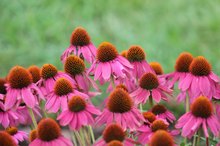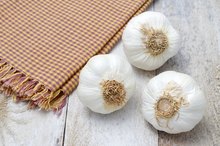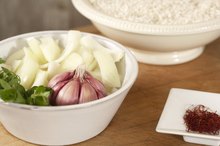Side Effects of Too Much Echinacea
Echinacea is believed by many to stimulate the immune system and help the body fight infection and has therefore been used for centuries to treat and prevent colds, the flu and other infections. Despite mixed results when it comes to studies evaluating its effectiveness, anecdotal evidence is such that it remains a popular health supplement. Although most side effects are mild, when used for a prolonged period of time or when too much is used there are some potential side effects that, while rare, can be serious.
Liver Damage
Echinacea that is taken long than eight weeks can potentially damage the liver, according to Columbia University's Health Q&A Internet Service. Increased liver enzyme activity, a symptom of liver damage, has been noted in liver transplant patients who take large doses of echinacea, according to MedlinePlus. For this reason, liver transplant patients should use extreme caution when using echinacea.
A Stronger Virus?
Herbs That Remove Toxins or Bacterial Infections From the Body
Learn More
The website AskDrSears.com points to a valid concern about echinacea. If one supports the claims that echinacea is effective in tampering with a virus' genetic makeup, then who is to say that any changes that take place could cause viruses to become stronger and more resistant? Much in the same way that certain bacterial infections have grown resistant to antibiotics, couldn't the same rationale apply to echinacea and viruses?
Possible Interactions
Echinacea may have a negative interaction with several drugs, according to the University of Maryland Medical Center. If you are undergoing treatment for cancer, are on immunosuppressants, you need to speak to your doctor before taking echinacea. However, UMMC reports that echinacea interacts positively with econazozle which is used as an antifungal. When used together, fungal infections are less likely to return.
- Echinacea may have a negative interaction with several drugs, according to the University of Maryland Medical Center.
- However, UMMC reports that echinacea interacts positively with econazozle which is used as an antifungal.
Lost Gains
Herbs to Increase White Blood Cells
Learn More
Using echinacea without taking a break can diminish or negate any positive benefits that have occurred. A report from Columbia University states that after six or eight weeks echinacea becomes ineffective. To prevent this from happening, CU recommends using echinacea for six to eight weeks followed by a one to two week break.
Related Articles
References
- National Center for Complementary and Alternative Medicine: Echinacea
- AskDrSears.com: Frequently Asked Questions About Echinacea
- University of Maryland Medical Center: Possible Interactions With Echinacea
- Memorial Sloan Kettering Integrative Medicine About Herbs, Botanicals & Other Products. Echinacea. https://www.mskcc.org/cancer-care/integrative-medicine/herbs/echinacea
- Natural Medicines Database: Therapeutic Research Center. Echinacea. https://naturalmedicines.therapeuticresearch.com/databases/food,-herbs-supplements/professional.aspx?productid=981
- UCLA Center for East-West Medicine. The Echinacea Controversy: Herbal Remedy for Colds? https://exploreim.ucla.edu/wellness/the-echinacea-controversy-herbal-remedy-for-colds/
- Restani P, Di Lorenzo C, Garcia-Alvarez A, et al. Adverse Effects of Plant Food Supplements Self-Reported by Consumers in the PlantLIBRA Survey Involving Six European Countries. PLoS One. 2016;11(2):e0150089. doi:10.1371/journal.pone.0150089
- Senica M, Mlinsek G, Veberic R, Mikulic-petkovsek M. Which Plant Part of Purple Coneflower (Echinacea purpurea (L.) Moench) Should be Used for Tea and Which for Tincture? J Med Food. 2019;22(1):102-108. doi:10.1089/jmf.2018.0026
- Wanwimolruk S, Prachayasittikul V. Cytochrome P450 enzyme mediated herbal drug interactions (Part 1). EXCLI J. 2014;13:347-391.
- Karsch-Völk M, Barrett B, Kiefer D, Bauer R, Ardjomand-Woelkart K, Linde K. Echinacea for preventing and treating the common cold. Cochrane Database Syst Rev. 2014;2(2):CD000530. doi:10.1002/14651858.CD000530.pub3
- National Center for Complementary and Integrative Health. Echinacea. Updated September 2016.
- Brown PN, Chan M, Paley L, Betz JM. Determination of major phenolic compounds in Echinacea spp. raw materials and finished products by high-performance liquid chromatography with ultraviolet detection: single-laboratory validation matrix extension. J AOAC Int. 2011;94(5):1400-1410.
- Hudson JB. Applications of the phytomedicine Echinacea purpurea (Purple Coneflower) in infectious diseases. J Biomed Biotechnol. 2012;2012:769896. doi:10.1155/2012/769896
- Memorial Sloan Kettering Integrative Medicine About Herbs, Botanicals & Other Products. Echinacea.
- Natural Medicines Database: Therapeutic Research Center. Echinacea.
- UCLA Center for East-West Medicine. The Echinacea Controversy: Herbal Remedy for Colds?
Writer Bio
Based in Charlotte, N.C., Virginia Franco has more than 15 years experience freelance writing. Her work has appeared in various print and online publications, including the education magazine "My School Rocks" and Work.com. Franco has a master's degree in social work with an emphasis in health care from the University of Maryland and a journalism degree from the University of Richmond.









